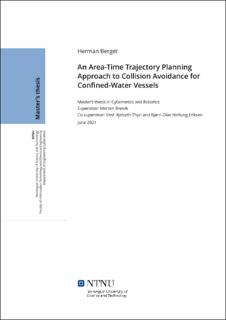| dc.contributor.advisor | Breivik, Morten | |
| dc.contributor.advisor | Thyri, Emil Hjelseth | |
| dc.contributor.advisor | Eriksen, Bjørn-Olav Holtung | |
| dc.contributor.author | Berget, Herman | |
| dc.date.accessioned | 2021-09-23T18:54:33Z | |
| dc.date.available | 2021-09-23T18:54:33Z | |
| dc.date.issued | 2021 | |
| dc.identifier | no.ntnu:inspera:76427839:21446360 | |
| dc.identifier.uri | https://hdl.handle.net/11250/2781076 | |
| dc.description.abstract | Denne masteroppgaven presenterer en baneplannleggingsmetode for Collision Avoidance
(COLAV) for en Autonomous Surface Vehicle (ASV) i trange farvann og med andre
fartøy i nærheten. Metoden baserer seg på å representere arbeidsområdet og alle relevante objekter i et tredimensjonalt rom som spennes av arbeidsområdet og tid. Ved å
gjøre dette blir COLAV-problemet redusert til et baneplanleggingsproblem i en ekstra
dimensjon. En graf som representerer et sett med kollisjonsfrie baner som er følgbare gitt
karakteristikken til fartøyet blir laget. Hver kant i grafen blir evaluert ved hjelp av en
kostnadfunksjon og banen med den laveste kostnaden blir valgt. Kostnadsfunksjon tar
hensyn til flere aspekter av omgivelsene og prøver å evaluere hvor kompatibel med The
International Regulations for Preventing Collisions at Sea (COLREG) en bane er. Ved å
gjøre dette forsøker algoritmen å lage en trygg bane fra startposisjonen til målposisjonen.
Gjennom simuleringer evalueres den foreslåtte metoden og den sammenlignes med
to andre metoder, Velocity Obstacle (VO) og Single Path Velocity Planner (SP-VP).
Simuleringene viser at den foreslåtte metoden klarer å generere trygge og intuitive baner
i mange av tilfellene. Den foreslåtte metoden gjør det bedre enn metodene det sammenlignes med med tanke på trygghet på bekostning av økt kompleksitet. I noen situasjoner,
spesielt der antagelsene om oppførselen til hindringene ikke gjelder, yter metoden suboptimalt. Endringer i omgivelsene kan føre til hyppig replanlegging hvor banen kan endres
på måter andre ikke forventer. | |
| dc.description.abstract | This master’s thesis presents a trajectory planning approach to Collision Avoidance
(COLAV) for an Autonomous Surface Vehicle (ASV) operating in confined space and in
the presence of other vessels. The proposed approach is based on representing all static
and dynamic features of the operational area in a three dimensional space, spanned by
the area and time. By doing this, the task of planning a collision free trajectory is reduced to a path-planning problem in three dimensions. A graph which represents a set of
collision free trajectories that are feasible for the vessel is built. Each edge of the graph
is then evaluated according to a cost function and the lowest cost trajectory is chosen.
The cost function considers several aspects of the surroundings, in addition to a cost
related to how compliant that edge is with respect to the The International Regulations
for Preventing Collisions at Sea (COLREG). By doing this the algorithm attempts to
create a safe trajectory from the start position to the destination.
Through simulations the proposed method is evaluated and compared to two other
methods for COLAV, namely Velocity Obstacle (VO) and Single Path Velocity Planner
(SP-VP). It is seen that the proposed method is able to create a safe and intuitive path in
many of the situations, and improves on the compared methods in terms of safety at the
cost of increased complexity. In some situations, notably where the assumptions about
the behavior of the obstacles does not hold, the performance of the method is suboptimal.
Changing environments can lead to frequent replanning where the trajectory may change
in ways other seafarers do not expect. | |
| dc.language | eng | |
| dc.publisher | NTNU | |
| dc.title | An Area-Time Trajectory Planning Approach to Collision Avoidance for Confined-Water Vessels | |
| dc.type | Master thesis | |
